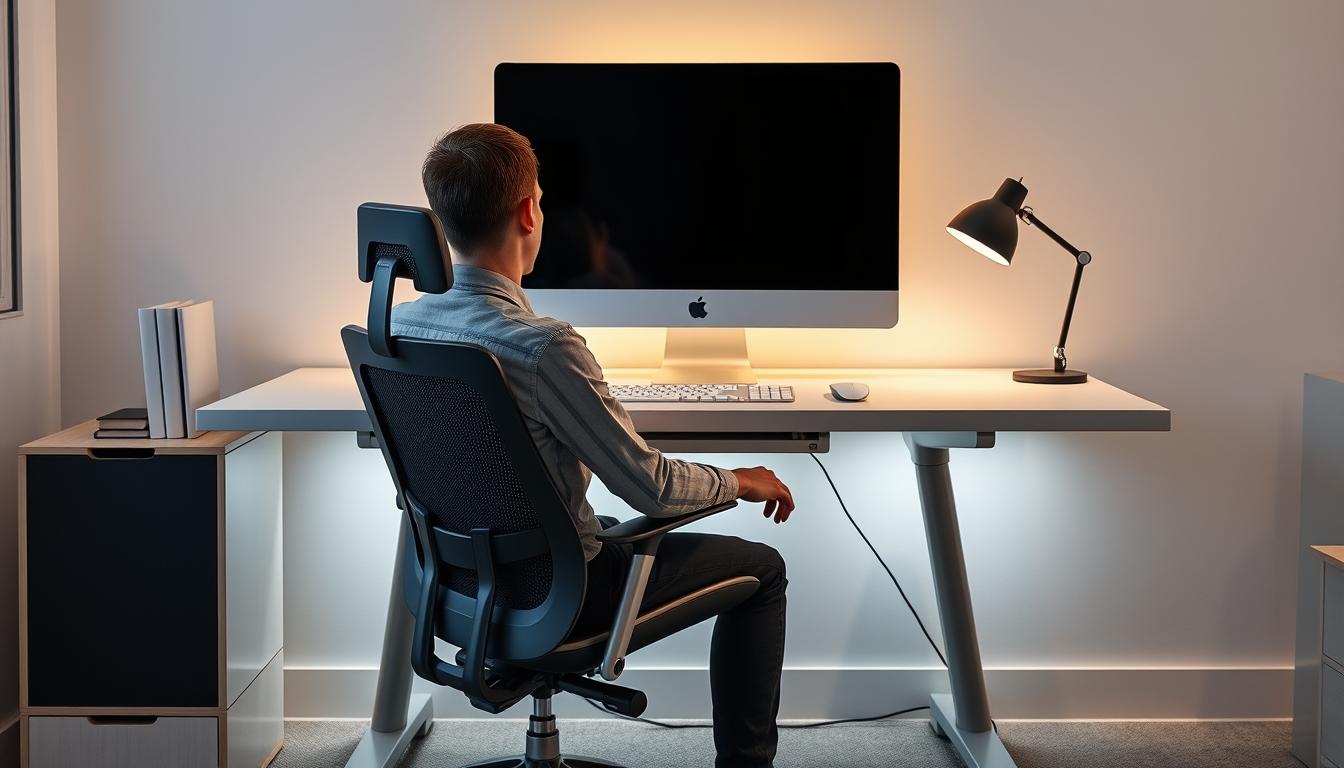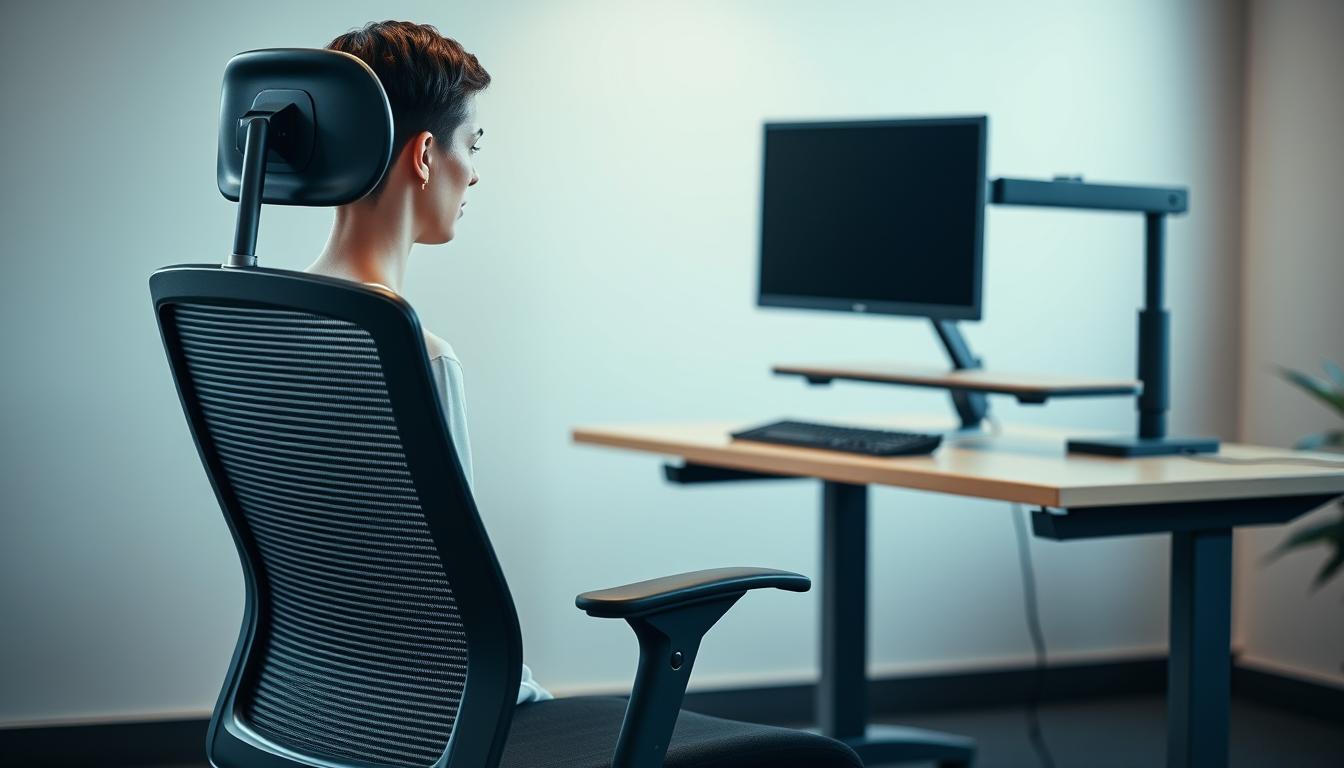Nowadays, many people feel neck strain, especially if they sit a lot at a desk. It’s important to sit correctly to ease neck strain and keep your body aligned. We’re going to talk about how to sit properly and share tips to reduce pain. This way, you can work better and feel more comfortable.
Understanding Neck Strain and Its Causes
Neck strain is common and can cause a lot of discomfort. It’s important to know why it happens. Poor posture, doing the same motion over and over, and sudden movements can hurt your neck. Knowing these reasons can help stop and treat neck strain.
Common Symptoms of Neck Strain
It’s critical to recognize neck strain symptoms early. Common signs include:
- Localized pain in the neck region
- Tightness or stiffness
- Pain spreading to the shoulders or arms
- Headaches
- Numbness or tingling in the hands
Often, these symptoms start from bad posture. This can get worse if not fixed.
Impact of Poor Posture on Neck Health
Poor posture can really hurt your neck. If you sit wrong, it can stretch and press on your neck. This damages your neck over time. If you keep straining your neck, it gets harder to get better. Keeping your posture right can make your neck feel better and hurt less.
Why Proper Sitting Posture Matters
Good posture is very important. It affects our comfort now and our health later on. Sitting wrong can cause neck pain. This could get worse over time if not fixed. Knowing about this helps us make better choices for our health.
Short-Term vs. Long-Term Effects of Bad Posture
At first, bad posture causes discomfort, tiredness, and tightness. This can feel like tension in your neck and shoulders. We call this short-term neck pain. If not fixed, this can lead to serious issues like chronic pain. It’s important to recognize this early for a healthier life.
Connection Between Sitting Posture and Neck Pain
Sitting the wrong way can hurt your neck. Leaning your head forward too much stresses your neck and spine. But, sitting properly can prevent this pain. It helps your neck stay healthy. Making small changes can really help you feel better.
Correct Sitting Posture to Reduce Neck Strain
Having the right sitting posture is very important to lessen neck strain and make you more comfortable. When you sit correctly, not only does it help with the pain, it also makes you more productive. Knowing and visualizing the correct way to sit can help you keep good habits all day.
Key Elements of Proper Posture
Here are the main things to focus on for the right sitting posture:
- Scoot all the way back in the chair to support your lower back.
- Utilize lumbar support to maintain a neutral spine position.
- Keep your feet flat on the floor or on a footrest.
- Position your knees at or below hip level.
- Align your head so that it sits directly above your shoulders, avoiding forward protrusion.
Visualizing Good Sitting Posture
Imagine yourself sitting up straight with your back straight and shoulders relaxed. This mental picture can act as a reminder of how you should sit. Keeping it in mind throughout the day can help you maintain good posture.
Steps for Achieving Good Sitting Posture
Good sitting posture is key for neck comfort and overall health. Start by adjusting your chair and organizing your workspace the right way. It eases neck strain and helps with spine health.
Adjusting Chair Height and Position
First, make sure your feet can touch the ground or a footrest from your chair. The right chair height keeps your thighs flat, which is best for circulation and stability. Your chair’s back should support your lower back and let your shoulders relax. This builds a solid base for a comfy posture all day.
Maintaining Neutral Spine Alignment
Keeping your spine aligned is essential to avoid neck pain. Sit straight with relaxed shoulders, avoiding any slumps or hunches. Follow tips for keeping your spine’s natural curve. Regularly check and adjust your sit to keep from getting tired, making sure your neck stays lined up with your body.
Setting Up Your Workspace Ergonomically
Creating an ergonomic workspace boosts comfort and gets more work done. It also lessens neck pain. A good desk setup means choosing the right furniture. This helps make work efficient and keeps you healthy. Think about your desk and chair plus where your monitor goes.
Desk and Chair Configuration
A good desk setup begins with the right chair. It should let you adjust its height and support your lower back. Your desk should be at a height that keeps your shoulders relaxed. Your arms should be flat on the desk when you type. Keep important stuff close to avoid reaching too far.
Monitor Height and Distance for Neck Comfort
To protect your neck, keep your monitor at eye level. It should be 18 to 24 inches from your face. This keeps your neck in a comfy position without bending or tilting. Tilting the monitor reduces glare. This helps you sit better and protects your neck.
Exercises to Support Neck Health While Sitting
Keeping your neck healthy while you sit is key to avoiding pain and feeling good overall. It’s a good idea to do neck exercises every day. They help get rid of tension and make your neck muscles stronger. Doing stretches also makes your neck more flexible and stops it from getting sore if you sit a lot.
Neck Stretches to Alleviate Tension
Doing some easy neck stretches can really help with tension and make moving easier. Try adding these stretches to what you do every day:
- Gently tilt your head side-to-side, holding each position for a few seconds.
- Roll your shoulders backwards and forwards to release tightness.
- Perform cervical retractions by tucking your chin towards your chest to help elongate the neck.
Strengthening Exercises for Neck Muscles
Having strong neck muscles is important to keep your posture good and reduce pain. Here are some great exercises to try:
- Seated thoracic extensions promote upper back strength, which supports the neck.
- Isometric neck exercises, where you push against your hand while resisting movement, can build endurance in neck muscles.
By doing these exercises and stretches regularly, your neck will be healthier. This can help stop the pain that comes from sitting in a bad position.

The Importance of Taking Breaks
It’s really important to take regular breaks. This is especially true if you sit for a long time. Breaks support both your body and mind. They keep you from getting stiff and help your blood flow better. Without breaks, you might start to feel tired and uncomfortable. This can make it hard to focus and do well at work.
Recommended Frequency of Breaks During Work
You should take a break about every 30 minutes if you sit a lot at work. Try standing up, stretching, or walking. Doing this can help you feel more alert. It also lowers the chance of having muscle or bone problems. Having a set schedule for breaks makes the workplace better for everyone.
Activities to Include During Breaks
What you do during breaks matters too. Here are some suggested activities:
- Neck mobility stretches to alleviate tension
- Short walks to stimulate circulation
- Simple breathing exercises to promote relaxation
- Quick standing stretches to relieve muscle tightness
These actions can help fight the downsides of sitting too much. They make a big difference in how you feel and work.
Common Mistakes in Sitting Posture
Many people don’t realize they’re developing bad posture habits. These habits can cause discomfort and pain. It’s key to know these mistakes to fix slouching and boost health. Making small changes can really help improve how you sit.
Identifying Poor Posture Habits
Knowing specific bad habits is vital for better posture. Common errors include:
- Slouching while sitting
- Leaning forward too much
- Craning the neck toward the screen or desk
Realizing you’re slouching or in a bad posture is the start of fixing it. Checking yourself often helps you see when you’re in these bad positions.
How to Correct Slouching or Forward Head Posture
Improving your posture takes real work. Try these strategies:
- Set reminders to check your alignment throughout the day.
- Practice engaging your core muscles to support a neutral spine.
- Take frequent breaks to reset your body’s position.
Using these tips can change your sitting habits for the better. This avoids discomfort and promotes a healthier sitting posture.
Additional Tips for Reducing Neck Strain
To cut down neck strain, mix different ways to move into your day. Moving more can ease tension and help you sit or stand better. Taking small breaks to stretch can make your neck feel better and boost your work output.
Incorporating Movement into Your Day
Adding simple movements to your daily routine can make a big difference in neck comfort. Try to take quick breaks to move around while you work. Here are a few tips to keep your neck happy:
- Stand up and stretch every hour.
- Use the stairs instead of the elevator when possible.
- Incorporate light aerobic exercises like walking.
- Practice neck rolls every few hours.
Using Supportive Accessories
Using the right desk accessories can greatly help with neck strain. Ergonomic tools and chairs can support a good posture. Look into these helpful accessories:
- Ergonomic chairs that promote spinal alignment.
- Footrests to enhance comfort and posture.
- Standing desks that allow for alternating between sitting and standing.
- Document holders to keep materials at eye level.
Consulting a Professional for Neck Issues
Having neck pain all the time can really make daily activities tough. It’s important to know when you need to get help to manage and improve your condition properly. Seeing physical therapists can give you access to expert advice and customized treatment plans that focus on what you specifically need for your neck pain.
When to Seek Help from a Physical Therapist
If you’re thinking about seeing a physical therapist for your neck, consider it:
- When the pain doesn’t get better after a few days.
- If mild pain turns into sharp or unbearable pain.
- If you start feeling numbness or tingling in your arms or hands.
- When neck pain makes everyday tasks difficult.
Common Treatments for Neck Pain Through Therapy
Physical therapists have a bunch of ways to treat neck pain. These methods can help you recover faster and help avoid future problems. They use:
- Manual therapy to lessen pain and make moving easier.
- Exercises to make your neck muscles stronger.
- Training on how to sit and stand straight properly.
- Tools like ultrasound and electrical stimulation to ease pain.
Conclusion
Correct posture is key to relieving neck strain. By understanding the causes of neck pain and how bad posture affects us, we can improve our comfort at work and home. Sitting right helps reduce pain and boosts health and work performance.
It’s important to practice good ergonomics, like adjusting your chair and screen. Plus, doing exercises and taking breaks helps ease strain and improves posture. By adopting better habits now, you’ll enjoy a life without neck pain in the long run.



